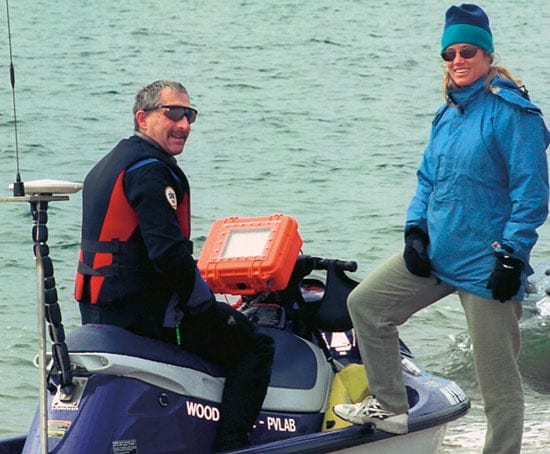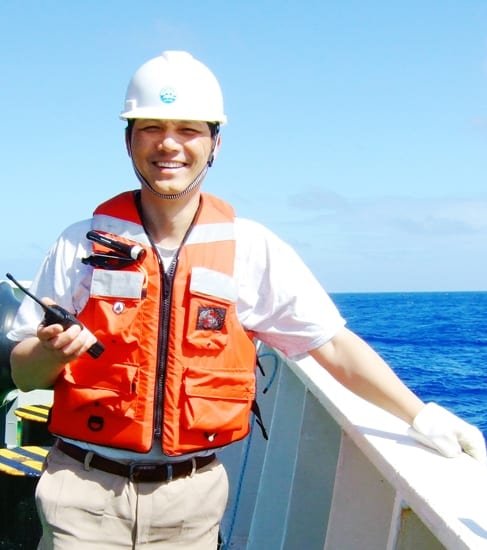News Releases
You Don’t Call, You Don’t Write: Connectivity in Marine Fish Populations
Children of baby boomers aren’t the only ones who have taken to setting up home far from where their parents live. A new study published this week in the Proceedings…
Read MoreElgar Named National Security Science and Engineering Faculty Fellow
Steve Elgar, a senior scientist in the Woods Hole Oceanographic Institution (WHOI) Applied Ocean Physics and Engineering department, was recently named a 2009 National Security Science and Engineering Faculty Fellow…
Read MoreWarming Climate Impacts Base of Food Web in Western Antarctic Peninsula
A paper published this week in Science shows for the first time that the warming climate is changing the numbers and composition of phytoplankton—the base of the food web—along the…
Read MoreRight whale sedation enables disentanglement effort
On Friday, March 6, 2009, for the first time ever, a North Atlantic right whale that had been severely entangled in fishing gear, was administered a sedation mixture that made…
Read MoreAirborne pollutants can be toxic to marine algae
A newly published paper by ocean scientists shows that airborne particles off the continents can have deadly effect on some marine phytoplankton. The findings, published in the online early edition…
Read MoreWHOI and RTDC Announce Technology Transfer Partnership
The Woods Hole Oceanographic Institution (WHOI) and the Regional Technology Development Corp. (RTDC) of Cape Cod announced jointly today the signing of a technology transfer and entrepreneurial services agreement designed…
Read MoreCarbon Acts Like Rustoleum Around Hydrothermal Vents
The cycling of iron throughout the oceans has been an area of intense research for the last two decades. Oceanographers have spent a lot of time studying what has been…
Read MorePhytoplankton Cell Membranes Challenge Fundamentals of Biochemistry
Get ready to send the biology textbooks back to the printer. In a new paper published in Nature, Benjamin Van Mooy, a geochemist with the Woods Hole Oceanographic Institution (WHOI),…
Read MoreOcean Islands Fuel Productivity and Carbon Sequestration Through Natural Iron Fertilization
An experiment to study the effects of naturally deposited iron in the Southern Ocean has filled in a key piece of the puzzle surrounding iron’s role in locking atmospheric carbon…
Read MoreEmperor Penguins March toward Extinction?
Popularized by the 2005 movie “March of the Penguins,” emperor penguins could be headed toward extinction in at least part of their range before the end of the century, according…
Read MoreDanube Delta Holds Answers to Noah’s Flood Debate
Did a catastrophic flood of biblical proportions drown the shores of the Black Sea 9,500 years ago, wiping out early Neolithic settlements around its perimeter? A geologist with the Woods…
Read MoreBacterial Pathogens and Rising Temperatures Threaten Coral Health
Coral reefs around the world are in serious trouble from pollution, over-fishing, climate change and more. The last thing they need is an infection. But that’s exactly what yellow band…
Read MoreMedia Advisory: Turtle Skulls Prove to be Shock-Resistant
Scientists and engineers from Woods Hole Oceanographic Institution (WHOI) and the U.S. Navy have discovered that sea turtles’ skulls and shells not only protect them from predators but also from…
Read MoreStudy links swings in North Atlantic Oscillation variability to climate warming
Using a 218-year-long temperature record from a Bermuda brain coral, researchers at the Woods Hole Oceanographic Institution (WHOI) have created the first marine-based reconstruction showing the long-term behavior of one…
Read MoreWHOI Physical Oceanographer Joe Pedlosky to Present Haurwitz Lecture at American Meteorological Society Meeting
Joseph Pedlosky, a physical oceanographer with the Woods Hole Oceanographic Institution, has been awarded the Bernhard Haurwitz Memorial Lectureship at the American Metrological Society’s 89th Annual Meeting in Phoenix, Arizona,…
Read MoreSurprising Return of North Atlantic Circulation Pump
One of the “pumps” contributing to the ocean’s global circulation suddenly switched on again last winter for the first time this decade, scientists reported Tuesday (Dec. 23) in Nature Geoscience.…
Read MoreJian Lin Named a Fellow of the American Association for the Advancement of Science
Jian Lin of the Woods Hole Oceanographic Institution (WHOI) has been named a fellow of the American Association for the Advancement of Science (AAAS). Election as a fellow is an…
Read MorePartnership Provides Autonomous Vehicles to Enable New Era of Deep Sea Research
The Woods Hole Oceanographic Institution (WHOI) has partnered with the Waitt Institute for Discovery to make deep-sea exploration technology and a world-class operations group broadly available for the oceanographic community.…
Read MoreCold Water Corals Conference to be Held in Woods Hole
On October 24, 2008, scientists from North America and Europe will meet at the Woods Hole Oceanographic Institution (WHOI) to develop the first coherent plan for studying and conserving cold-water…
Read MoreStudy Reveals Microbes Dine on Thousands of Compounds in Oil
Thousands of feet below the bottom of the sea, off the shores of Santa Barbara, CA, single-celled organisms are busy feasting on oil. Until now, nobody knew how many oily…
Read MoreNew Marine Mammal Center Formed at Woods Hole Oceanographic Institution
The Woods Hole Oceanographic Institution (WHOI) has announced the formation of a new center for marine mammal research and conservation studies. The center combines scientific expertise, state-of-the-art facilities, and technological…
Read MoreMay 2008 Earthquake in China Could Be Followed by Another Significant Rupture
Researchers analyzing the May 2008 Wenchuan earthquake in China?s Sichuan province have found that geological stress has significantly increased on three major fault systems in the region. The magnitude 7.9 quake on May 12 has brought several nearby faults closer to failure and could trigger another major earthquake in the region.
Read MoreJames R. Luyten Named Director of Red Sea Science and Engineering Research Center
King Abdullah University of Science and Technology (KAUST) today announced that Dr. James R. Luyten, one of the world’s most respected and accomplished oceanographic researchers, will become Director of the…
Read MoreWHOI VP for Marine Operations Bob Detrick Appointed to NSF Post
The National Science Foundation (NSF) Directorate for Geosciences has appointed Robert Detrick of the Woods Hole Oceanographic Institution (WHOI) as its new director of the Division of Earth Sciences. Detrick…
Read More

